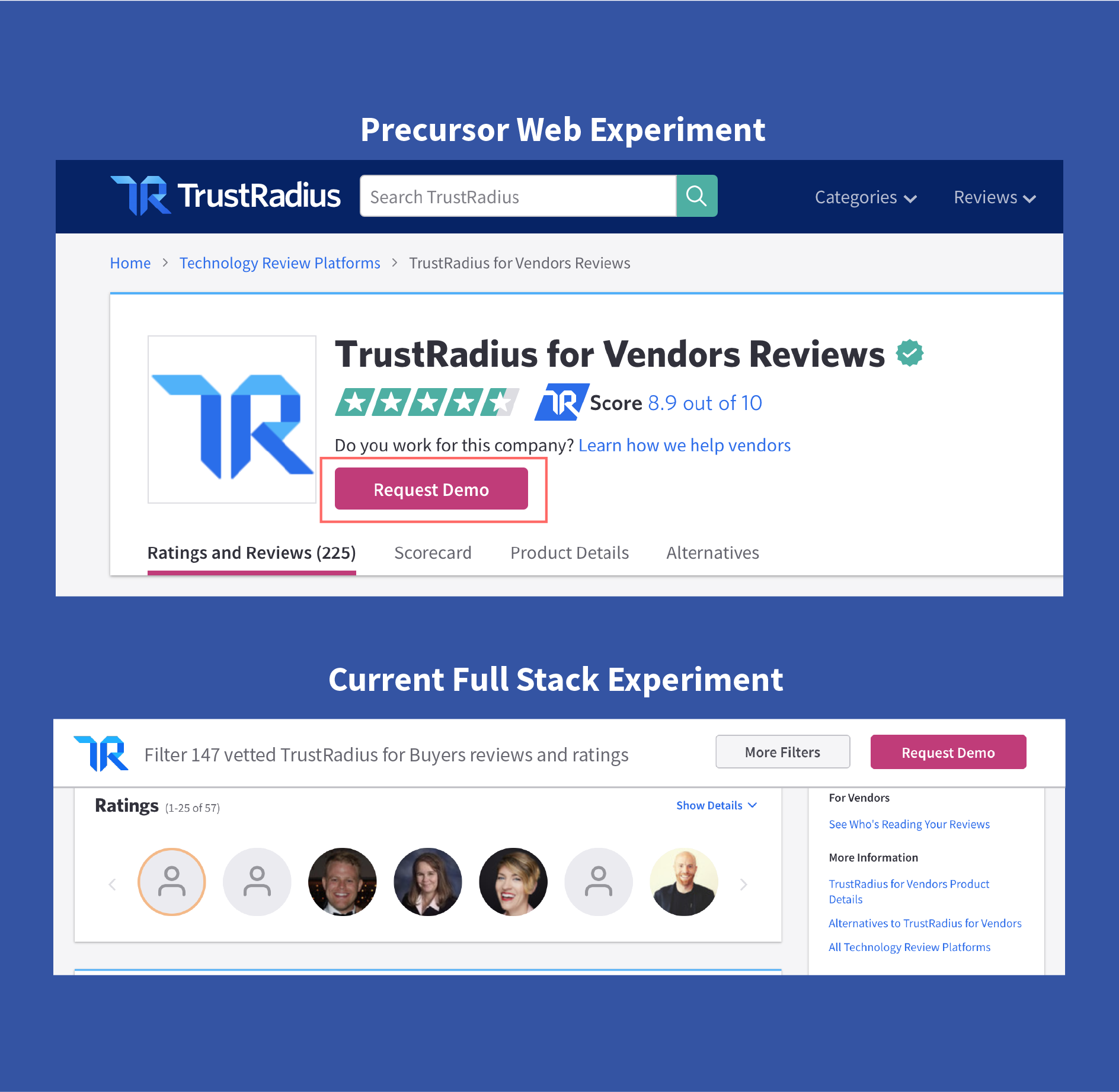Vertrauen auf Experimentieren, um es richtig zu machen
TrustRadius ist die am schnellsten wachsende und vertrauenswürdigste Plattform für Kundenstimmen und -einblicke, die Technik-Einkäufern hilft, gute Entscheidungen zu treffen, und Technik-Anbietern dabei hilft, gute Kunden zu gewinnen und zu binden. Jeden Monat nutzen mehr als 1 Million Käufer von Technik im B2B-Bereich die verifizierten Rezensionen und Bewertungen auf TrustRadius.com, um fundierte Kaufentscheidungen zu treffen. Hinter diesem großen Publikum steht ein äußerst innovatives Team aus Full Stack-Ingenieuren und Produktmanagern, die alle mit Hilfe von Optimizely experimentieren, um das Erlebnis von TrustRadius für Millionen von Nutzern auf der ganzen Welt entscheidend zu verbessern.
"Wenn man Produkte entwickelt, will man keine teuren Fehler machen. Experimente helfen uns dabei, die Nutzer in den Mittelpunkt zu stellen, Risiken zu minimieren und die Akzeptanz zu erhöhen, indem wir das Feedback der Nutzer frühzeitig einbeziehen."
Testen auf dem Weg zum Testen
TrustRadius hat sich vor etwas mehr als zwei Jahren buchstäblich den Weg ins Testen gebahnt. Das clevere und agile Team hat das Experimentieren in den Mittelpunkt seines Ethos gestellt, eine kundenorientierte Plattform zu sein, die ständig nach neuen Wegen zur Innovation und Verbesserung sucht. Das TrustRadius-Team begann seine Reise in das Experimentieren mit einer kostenlosen Lösung, die jedoch bald nicht mehr ausreichte, und suchte nach einer Lösung, die den Anforderungen des Unternehmens besser gerecht werden würde. Das Team nutzte die Site von TrustRadius, um nach der von Nutzern am besten bewerteten Plattform zum Experimentieren zu suchen - und landete bei Optimizely. Der Rest ist Geschichte: Allein im letzten Jahr hat TrustRadius 90 Experimente durchgeführt und dabei die gesamte Plattform von Optimizely genutzt, einschließlich der Full Stack- und Web-Produkte.
TrustRadius hat das Experimentieren genutzt, um die Grenzen dessen zu erweitern, was mit dem Erlebnis der Nutzer möglich war. Das Team konzentrierte sich darauf, 100 Prozent seiner Zielgruppe zu erreichen und sicherzustellen, dass seine Nutzer die richtigen Erkenntnisse finden, um die bestmöglichen Entscheidungen zu treffen. Das bedeutete, dass das Feedback der Endnutzer aus der Community für TrustRadius von zentraler Bedeutung war, um das bestmögliche Erlebnis für die Nutzer zu schaffen. Es war unmöglich, das Feedback von Millionen von Nutzern 1:1 zu berücksichtigen, aber mit Optimizely war das Team in der Lage, Metriken sofort zu überprüfen, die die Erlebnisse der Nutzer bei jedem Test widerspiegelten. Das bedeutete, dass das Feedback der Nutzer in jede Phase des Produktentscheidungsprozesses (Idee, Entwicklung, Markteinführung, Lernen) eingebettet werden konnte und dem Team half, Entscheidungen zu verbessern und kostspielige Fehler zu vermeiden.
Auf die Plätze, fertig, experimentieren!
TrustRadius begann das Experimentieren mit einer seiner leistungsstärksten Funktionen, den TrustMaps. TrustMaps sind Diagramme, die Benutzern helfen, bestimmte Softwareprodukte auf der Grundlage von Echtzeitdaten der Endbenutzer zu vergleichen. Da diese Diagramme große Mengen komplexer Inhalte enthalten, brauchten die Seiten mit TrustMaps länger als ideal, um zu laden, was wiederum das Erlebnis für den Benutzer störte.
Das Team wusste, dass es die Ladezeit der Seite verkürzen musste, war sich aber bewusst, dass die Änderungen nicht zu Lasten anderer Funktionen auf der Seite gehen durften, da dies auch das Engagement der Benutzer beeinträchtigen könnte. Sie begannen, verschiedene Optionen für die Anzeige auf der TrustMap zu testen. Schließlich stellte sich heraus, dass die beste Option die Verwendung eines statischen Bildes auf der Haupt Landing Page war, auf das die Kunden dann klicken konnten, um Zugang zur vollständigen TrustMap und ihren detaillierten Informationen zu erhalten. Auf diese Weise konnten die Nutzer schneller auf die für sie wichtigen Daten zugreifen, ohne darauf warten zu müssen, dass eine Menge unnötiger Daten auf der Startseite geladen werden.
Das Team konnte einen großen Unterschied bei den Ergebnissen feststellen. Die siegreiche TrustMap-Variante hatte viermal so viele Benutzerinteraktionen wie die anderen Varianten, die das Team getestet hatte. Außerdem verringerte sich die durchschnittliche Ladezeit der Seite um 0,2 Sekunden und die Abbruchrate sank ebenfalls um 3 Prozent. Ein Gewinn für alle.
Aufforderung zu Aktionen
Eines der bisher erfolgreichsten Experimente von TrustRadius war das Testen der Position der Call-to-Action-Schaltflächen (CTA) auf der Site. Sie wussten aus Umfragen, dass die Hälfte der Softwarekäufer während ihrer Buyer Journey Anbieter konsultieren. Daraus schlossen sie, dass viele Käufer eine Demo des Anbieters wünschen würden. Die CTA-Schaltfläche, die die Kunden zur Demo führte, ging jedoch verloren, wenn die Benutzer auf der Seite nach unten scrollten.
Das Team war der Meinung, dass es zu einer höheren Klickrate und einem besseren Erlebnis führen würde, wenn man es den Käufern erleichtern würde, die CTA-Schaltfläche für die Demo-Anforderung zu finden. Sie führten ein Experiment durch, um diese Hypothese zu testen. Dazu änderten sie die Position der Schaltfläche und platzierten die Call-to-Action an einer statischen Stelle in der Kopfzeile. Die ersten Ergebnisse zeigten, dass das Team durch diese Maßnahme eine unglaubliche Steigerung der Klickrate um das Zweifache erreichte! Angesichts dieses eindeutigen Erfolgs konnte das Team dann in eine dauerhafte Änderung der Position dieser CTA-Schaltfläche investieren.

Nachdem das Experimentieren mit der CTA-Schaltfläche für Verkäufer-Demos so erfolgreich war, führte TrustRadius ein ähnliches Experiment mit der Position der CTA-Schaltfläche "Link anfordern" durch. Nachdem das Team verschiedene Positionen auf der Seite ausprobiert hatte, gelang es ihm, die wöchentliche Anzahl der Anbieterprofile um mehr als 200 Prozent zu erhöhen!
Was kommt als nächstes?
Wir planen, Optimizely weiterhin zu nutzen, um nutzerzentriert zu bleiben und fundierte Produktentscheidungen zu treffen, und unser Experimentieren zu skalieren, wenn unser Unternehmen und unsere Zielgruppe weiter wachsen.
Wir werden die Fähigkeit unserer Plattform weiter verbessern, Millionen von Fachleuten zum richtigen Zeitpunkt mit den richtigen Antworten auf B2B-Techniken zu verbinden. Dazu werden wir Hunderte von neuen Experimenten im Web und im gesamten Stack durchführen, die in ihrer Komplexität von punktuellen Mutationen bis zur Validierung großer Roadmap-Initiativen reichen.
Die Bereiche, mit denen wir in nächster Zeit speziell experimentieren, sind Bereiche, in denen wir Käufern helfen können, Produkte mithilfe unserer Plattform einfacher zu bewerten. Das bedeutet, dass wir neue Arten von Inhalten und Daten testen, die auf eine Weise bereitgestellt werden, die einfach zu navigieren und auf die spezifischen Anwendungsfälle jedes Käufers personalisiert ist.

